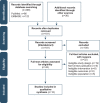Ferric Carboxymaltose for Anemic Perioperative Populations: A Systematic Literature Review of Randomized Controlled Trials
- PMID: 34079413
- PMCID: PMC8165212
- DOI: 10.2147/JBM.S295041
Ferric Carboxymaltose for Anemic Perioperative Populations: A Systematic Literature Review of Randomized Controlled Trials
Abstract
Importance: Perioperative anemia is a common comorbid condition associated with increased risk of morbidity and mortality in patients undergoing elective surgical procedures.
Objective: We conducted a systematic literature review (SLR) to determine the efficacy and safety of the use of intravenous ferric carboxymaltose (FCM) for the treatment of perioperative anemia in preoperative, intraoperative, and postoperative elective surgical care.
Evidence review: Studies meeting inclusion criteria for the SLR reported on treatment efficacy in an adult study population randomly allocated to FCM for the treatment of perioperative anemia during the perioperative period. After screening, 10 of 181 identified studies from searches in MEDLINE and EMBASE databases were identified for inclusion in this review.
Findings: Preoperative treatment was reported in six studies, intraoperative treatment in one study, postoperative treatment in two studies, and both pre- and postoperative treatment in one study. Together, 1975 patients were studied, of whom 943 were randomized to FCM, of whom 914 received FCM treatment. The 10 studies reported elective surgical populations for colorectal, gastric, orthopedic, abdominal, urologic, plastic, neck, gynecologic, and otolaryngologic procedures. Given the clinical and methodological heterogeneity of the studies, the analyses were limited to qualitative assessments without meta-analyses. All 10 studies reported statistically greater changes in hemoglobin concentration, serum ferritin, and/or transferrin saturation with FCM treatment compared with comparators (placebo, oral iron, standard care, or a combination of these). Two studies reported statistically significant differences in transfusion rate and 2 studies reported significant differences in length of hospital stay between FCM and its comparator(s).
Conclusions and relevance: This SLR adds to existing data that administration of FCM in preoperative and postoperative settings improves hematologic parameters. Several studies in the review supported the beneficial effects of FCM in reducing transfusion rate and length of stay. Larger, well-designed, longer-term studies may be needed to further establish the efficacy and safety of FCM in elective surgery patients with perioperative anemia.
Keywords: elective surgery; hemoglobin; intravenous iron; iron-deficiency anemia; patient blood management.
© 2021 Jones et al.
Conflict of interest statement
John Jeffrey Jones was a postdoctoral fellow employed by St. John’s University (Jamaica, NY, USA) through a grant funded by American Regent, Inc. John Jeffrey Jones is currently employed by AVROBIO, Inc.; AVROBIO, Inc. was not involved in the content of this research or manuscript preparation. Linda M. Mundy, Nicole Blackman, and Michelle Shwarz are employees of American Regent, Inc., a wholly owned subsidiary of Daiichi Sankyo.
Figures



Similar articles
-
Preoperative Single-Dose Intravenous Iron Formulation to Reduce Postsurgical Complications in Patients Undergoing Major Abdominal Surgery: A Randomized Control Trial Feasibility Study (PIRCAS Trial Pilot).Cureus. 2021 Aug 21;13(8):e17357. doi: 10.7759/cureus.17357. eCollection 2021 Aug. Cureus. 2021. PMID: 34567897 Free PMC article.
-
Clinical, economical and safety impact of ferric carboxymaltose use in Patient Blood Management programme in Portuguese National Health Service hospitals.Sci Rep. 2022 Nov 11;12(1):19335. doi: 10.1038/s41598-022-21929-3. Sci Rep. 2022. PMID: 36369296 Free PMC article.
-
Ferric carboxymaltose reduces transfusions and hospital stay in patients with colon cancer and anemia.Int J Colorectal Dis. 2016 Mar;31(3):543-51. doi: 10.1007/s00384-015-2461-x. Epub 2015 Dec 22. Int J Colorectal Dis. 2016. PMID: 26694926 Free PMC article.
-
The Effect of Perioperative Intravenous Iron on Hemoglobin in Surgical Patients: A Meta-Analysis.J Surg Res. 2020 Feb;246:42-51. doi: 10.1016/j.jss.2019.08.023. Epub 2019 Sep 24. J Surg Res. 2020. PMID: 31561177
-
A systematic literature review and indirect comparison of iron isomaltoside and ferric carboxymaltose in iron deficiency anemia after failure or intolerance of oral iron treatment.Expert Rev Hematol. 2019 Feb;12(2):129-136. doi: 10.1080/17474086.2019.1575202. Epub 2019 Feb 19. Expert Rev Hematol. 2019. PMID: 30689458
Cited by
-
[Diagnosis and treatment of perioperative anaemia in elective primary hip and knee arthroplasty : Consensus statement of the "Committee for Perioperative Management" of the Working Group for Endoprosthetics].Orthopadie (Heidelb). 2025 Feb;54(2):115-121. doi: 10.1007/s00132-024-04602-7. Epub 2025 Jan 20. Orthopadie (Heidelb). 2025. PMID: 39833316 German.
-
Efficacy and Safety of Ferric Carboxymaltose in the Management of Iron Deficiency Anemia: A Multi-Center Real-World Study from India.J Blood Med. 2022 Jun 8;13:303-313. doi: 10.2147/JBM.S361210. eCollection 2022. J Blood Med. 2022. PMID: 35706850 Free PMC article.
-
Consensus of the Brazilian association of hematology, hemotherapy and cellular therapy on patient blood management: Assessment and management of postoperative anemia.Hematol Transfus Cell Ther. 2024 Apr;46 Suppl 1(Suppl 1):S72-S76. doi: 10.1016/j.htct.2024.02.014. Epub 2024 Mar 19. Hematol Transfus Cell Ther. 2024. PMID: 38580494 Free PMC article.
-
Intravenous iron and iron deficiency anemia in patients with gastrointestinal cancer: A systematic review.PLoS One. 2024 May 22;19(5):e0302964. doi: 10.1371/journal.pone.0302964. eCollection 2024. PLoS One. 2024. PMID: 38776289 Free PMC article.
-
Predictors for Perioperative Blood Transfusion in Patients Undergoing Open Cystectomy and Urinary Diversion and Development of a Nomogram: An Observational Cohort Study.J Clin Med. 2021 Jun 25;10(13):2797. doi: 10.3390/jcm10132797. J Clin Med. 2021. PMID: 34202030 Free PMC article.
References
Publication types
LinkOut - more resources
Full Text Sources
Medical

